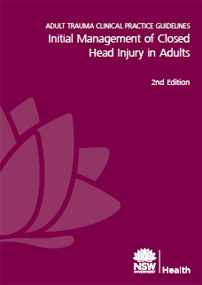Published: November 2011. Next review: 2023
Trauma is the leading cause of death and disability in children and young adults in NSW and closed head injuries cause a significant proportion of this burden. Closed head injury may result in lifelong physical, cognitive, behavioural and social dysfunction for patients, which in turn may place major social and financial burdens on their families and society.

The guideline is concerned with the initial care of patients with a head injury. It makes evidence based recommendations on the diagnosis, resuscitation, management and discharge of patients with mild, moderate or severe closed head injuries.
The guideline includes algorithms, discussions, tables of evidence, appendices and references.
Author: Dr Duncan Reed, Trauma Director, Gosford Hospital.
Download the guideline (PDF 1.8 MB)
Supporting resources
These are extracts from the guideline.
Summary report (PDF 814.9 KB) – contains algorithms and guidelines.
Algorithm 1 (PDF 122.1 KB) – A3 colour algorithm for adult closed head injuries.
Algorithm 2 (PDF 98.2 KB) – A3 colour algorithm for adult mild closed head injuries.
Discharge advice (PDF 599.5 KB) – two page mild head injury discharge advice sheet.
Please note that this guideline is an attachment to the NSW Health Policy Directive PD2012_13 advising of the update to the second edition and to ensure that all local health districts have protocols in place based on the key principles of the guideline.
Clinical questions
The development of the guideline was based on assessing these clinical questions.
- What is the definition of a mild head injury?
- What are the clinically-important complications of mild head injury?
- How should patients with mild head injury be assessed?
- Which patients with mild head injury require a CT scan?
- What should be done with high-risk mild head injury patients when CT scan is unavailable?
- What should be done when patients with mild head injury deteriorate?
- When can patients with mild head injury be safely discharged?
- What discharge advice should be provided?
- What are the proven treatments for patients with moderate head injury?
- What are the proven treatments for patients with severe head injury?
- When should patients with closed head injury be transferred to hospitals with neurosurgical facilities?
- What analgesia should patients with closed head injury receive?
- Which patients with closed head injury should receive anti-convulsants?